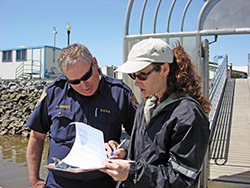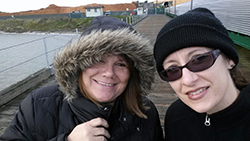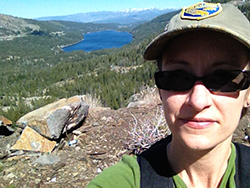
OSPR’s Jim Hughes and Annie Nelson evaluate an oil spill exercise at the Larkspur Ferry Terminal.

Annie Nelson and Ima Doty on the Schnyder dock in Eureka

Annie Nelson atop Donner Pass, where OSPR has responded to two past pipeline oil spills
Annie Nelson is in her second year as CDFW’s Office of Spill Prevention and Response (OSPR) specialist for best achievable technology, focusing on mechanical oil spill response equipment. She began her career with OSPR as a scientific aid a few months after earning her Bachelor of Science degree in wildlife management from Humboldt State University. She gained permanent employee status as an analyst, working in the Natural Resource Damage Assessment Program. She found it rewarding to witness and coordinate post-spill restoration efforts, but after about seven years, a move to the drills and exercises unit opened the door for her to the world of response preparedness as an environmental scientist. Establishing and fortifying that program took Nelson through the next eight years of her career, before accepting her current position.
What keeps her at OSPR are the wonderful people, the constant learning curve and the many unique opportunities the spill response world provides.
Who or what inspired you to become a scientist?
In 5th or 6th grade, the cutest boy in my class expressed that science was his favorite subject. That was the spark for me. Once I started exploring science, I realized it was really cool and fun to learn. I enjoyed biology and chemistry during high school and became hooked on understanding how our planet operates – down to the molecular level.
What got you interested in working with wildlife?
My senior year of high school came with the opportunity to participate in the Regional Occupational Program (ROP) and I chose “Animal Careers.” The ROP offered classroom education as well as hands-on experience in your field of choice. When it was time to choose jobsites, most of my fellow classmates in the animal careers course worked with veterinarians. I was fortunate enough to get a spot with Wild Things, Inc., an exotic animal facility near my home. I prepared diets and fed the animals, handled them for educational shows and cleaned up after them. I got to work with a variety of wildlife species, from big cats to primates to birds and reptiles – even a sea lion. When it was time to look at colleges and career opportunities, I combined my love for animals with science and studied wildlife at Humboldt State.
Who or what brought you to CDFW? What inspires you to stay?
My dad encouraged me to pursue a career with the state. CDFW was the first agency that came to mind. I applied for the warden cadet academy, wanting to enforce the laws that protect wildlife in California. Unfortunately, my vision disqualified me. I got my foot in the door with a CDFW scientific aid position in the Office of Spill Prevention and Response. I knew very little about oil spills at the time, but 17 years later I am a senior environmental scientist (specialist). My love for this team and continual learning since my first day on the job has kept me with OSPR.
What is a typical day like for you at work? Please describe a “day in the life.”
I usually spend my early morning hours researching online for any new articles that have come out regarding oil spill technology. My focus is mechanical equipment for containment and recovery, for example: boom, sorbents and skimmers. The goal is to evaluate as many as possible and develop a program for best practices. I also develop workshops. Right now, I’m helping to create an agenda for a workshop that focuses on response to spills of oils called bitumen. Bitumen is the consistency of peanut butter at room temperature and sinks in water, making cleanup difficult. This is an area that hasn’t had much advancement with technology but is a growing concern for responders.
As OSPR’s fisheries closure coordinator, I’m the contact person for calls during the work day from field staff who are either participating in an exercises or responding to actual spills for consultation regarding fishery closures due to oil spills. I gather information to provide the Office of Environmental Health Hazard Assessment (OEHHA), the agency that evaluates our information and provides recommendations on whether to close or keep the fishery open. Our agencies work together to determine whether a fisheries closure is necessary, where it will be, and how long it will last during oil spills. Currently, I am working on a presentation to take to our field responders that educates them about this process and their role in it. There is so much to learn, I am never bored!
What is the most rewarding project that you’ve worked on for CDFW?
In my second position at OSPR, I joined a brand new team that became the drills and exercises unit. Our role was to ensure that the oil industry in California was prepared to respond to spills. I helped build the program from the ground up, re-writing regulations and evaluating hundreds of response drills and exercises all over the state. Industry soon realized that we meant business and they were quick to comply. Improving spill preparedness through the relationships fostered between OSPR and the oil industry we regulate proved rewarding.
Over the course of your career, was there a discovery or an incident that surprised you?
The most jaw-dropping incident that has occurred during my career was the Deepwater Horizon oil spill in the Gulf of Mexico in 2010. The Macondo well head poured more than 3 billion gallons of crude oil into the Gulf from 5,000 feet below the surface. Eleven people lost their lives when the rig blew up, and it took 87 days to cap the well. This still blows my mind to think about. Although I wasn’t one of them, quite of few of my OSPR co-workers responded to the incident. It was a proud moment for the OSPR team to bring experience and resources to the disaster and help.
If you had free reign and unlimited funding, what scientific project would you most like to do?
I’ll stick with my current field. I’d love to conduct studies of the wildlife species most commonly injured by oil spills, in order to develop humane but highly effective hazing techniques and technology. In order to avoid mass wildlife casualties, quick containment of a spill is crucial; however, this doesn’t often occur. Hazing is sometimes necessary to keep animals away from the slick, but the effectiveness is hit-or-miss. I’d be interested in developing some new biology-based tools for hazing to reduce the need for rehabilitation (washing), which can be stressful on wildlife and take up resources.
What is the best thing about being a wildlife scientist?
Knowing that my work ultimately protects California’s wildlife from injury during oil spills is pretty great in itself, but my favorite part of the job is working directly with animals. It’s not every day that I get to handle a common murre or a grebe, but I’ve had opportunities to work in the oiled wildlife care facility in Cordelia, which brought me back to my high school days – feeding birds and cleaning cages. These experiences are always a treat.
Any advice for people considering careers in science or natural resources?
I think that career seekers need to ask themselves three questions: What is my passion, what am I good at, and what opportunities are out there? If you can match up at least two of these with your chosen career path, you have a good chance for success. What I love about the fields of science and natural resources is that our planet is always changing. We will never know everything there is to know and there will always be new discoveries and a need for scientists to study, protect and improve our environment.
Top photo: Annie Nelson (right) and Andrea Moore prepare to board a tug and observe an on-water boom deployment in El Segundo.
CDFW photos